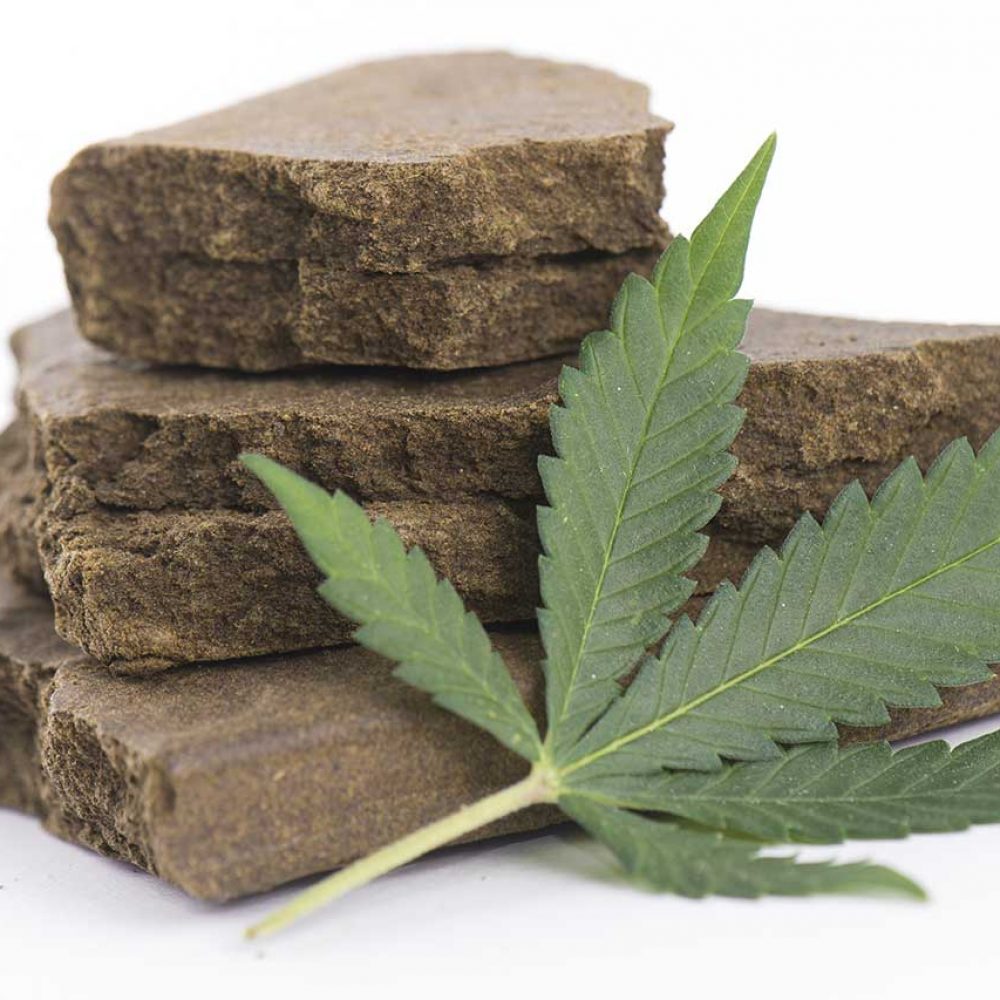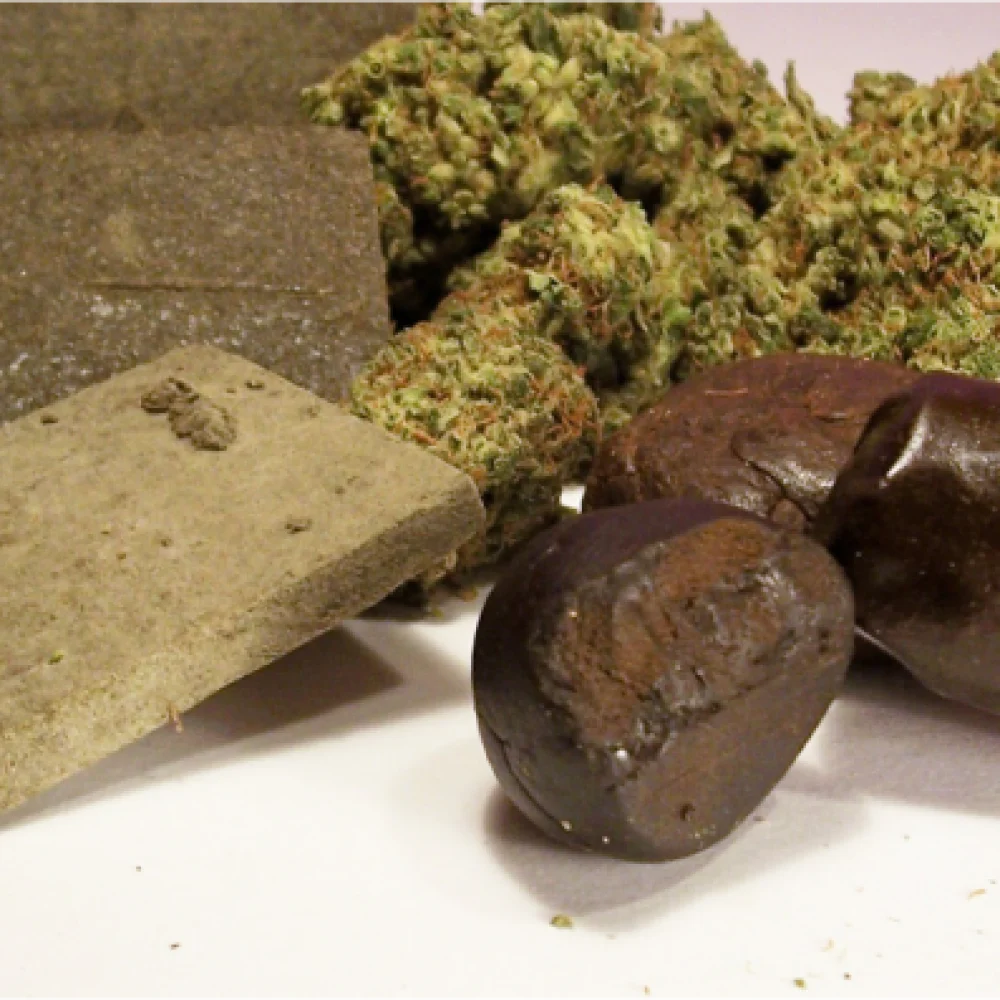What is hashish, you ask? How is it different from cannabis? Well, cannabis and hash both derive from the Cannabis sativa plant. But they have distinct characteristics that set them apart. Cannabis refers to the dried flowers, leaves, stems, and seeds of the plant, which contain various compounds. It is typically consumed by smoking, vaporizing, or ingesting.
On the other hand, hash, also known as hashish, is a concentrated form of cannabis. It is made by separating the resinous trichomes from the plant material and compressing them into a solid block or powder. Hash is known for its higher potency compared to regular cannabis, as it contains a higher concentration of cannabinoids. It is commonly smoked or vaporized. While both cannabis and hash offer recreational and medicinal effects, hash is often sought after for its concentrated potency and unique flavor profile.

Credit to Banyan Treatment Center
Understanding Hashish: A Historical Odyssey
Hashish holds a mystique that has captivated enthusiasts for centuries. Derived from the resin of the cannabis plant, hashish, or hash, is a concentrated form of cannabis with a rich history and a diverse array of traditions surrounding its production and consumption. This comprehensive guide delves into the origins, production methods, varieties, effects, and cultural significance of hashish, providing readers with an in-depth understanding of this ancient and revered cannabis product.
1. Ancient Roots:
Hashish has ancient origins, with historical records suggesting its use in regions like India, the Middle East, and North Africa dating back thousands of years. It holds cultural and spiritual significance in various traditions, often associated with rituals and rites.
2. Traveling the Silk Road:
The Silk Road played a pivotal role in the spread of hashish, facilitating its journey from the East to the West. As trade routes flourished, hashish found its way into different cultures, influencing artistic, religious, and philosophical movements.
3. Hashish in Literature and Art:
From the works of literary giants like Baudelaire and Rimbaud to iconic artists like Bob Marley, hash has left an indelible mark on creative expression. Its inclusion in literature, music, and visual arts reflects its cultural resonance and significance.
Unraveling the Chemistry: What Makes Hashish Unique
1. Resin Extraction:
Hashish is primarily derived from the resin glands, or trichomes, that cover cannabis flowers. The resin contains cannabinoids, terpenes, and other compounds responsible for the plant’s psychoactive and therapeutic effects.
2. Cannabinoid Concentration:
Hashish is renowned for its potency, thanks to the concentrated levels of cannabinoids, particularly THC (tetrahydrocannabinol). This results in a more intense and immediate experience compared to traditional cannabis flower.
3. Terpene Profiles:
Terpenes, aromatic compounds responsible for the distinctive scents of cannabis strains, also contribute to the flavor and effects of hashish. The terpene profile can vary based on the cannabis strain used in hashish production.
Production Methods: Crafting the Essence
1. Traditional Hand-Rubbing:
In regions like Morocco and Afghanistan, traditional hashish production involves hand-rubbing cannabis plants to collect resin. This labor-intensive method produces high-quality hash with distinct textures and flavors.
2. Dry Sifting:
Dry sifting involves mechanically separating trichomes from the plant material using screens or mesh. The collected resin glands are then pressed to form hash. This method allows for a range of textures, from powdery kief to more solid forms.
3. Ice Water Hash:
Also known as bubble hash, this method utilizes ice water and agitation to separate trichomes from the plant material. The resin is collected using screens or mesh bags, resulting in a clean and potent hashish product.
4. Rosin Tech:
A modern approach, rosin tech involves using heat and pressure to extract resin from cannabis flowers. This solventless method has gained popularity for its simplicity and ability to preserve terpenes.
Varieties of Hashish: A World of Flavors and Textures
1. Traditional Hash Varieties:
- Afghani Hash: Known for its dark color and earthy flavor, Afghani hash is a traditional product from the rugged landscapes of Afghanistan.
- Moroccan Hash: Often light in color and with a spicy aroma, Moroccan hash is famous for its hand-rubbed production method.
- Lebanese Hash: Lebanese hash is recognized for its aromatic profile, combining floral and spicy notes.
2. Modern Hash Varieties:
- Bubble Hash: This water-extracted hash comes in various grades, from full-melt to lesser-refined forms.
- Rosin Hash: Rosin tech produces a solventless hash with a terpene-rich profile, preserving the essence of the original strain.
- Blended Hash: Some producers create unique blends, combining different strains to achieve specific flavor profiles and effects.

Credit to Zinnia Health
Consuming Hashish: A Journey into Elevation
1. Smoking Traditions:
Smoking remains a classic method of consuming hash. Whether in a joint, pipe, or bong, hashish can be mixed with tobacco or cannabis flower for a potent smoking experience.
2. Vaporizing:
Vaporizing hash involves heating the concentrate to a temperature that releases cannabinoids and terpenes without combustion. This method offers a cleaner and more flavorful experience.
3. Dabbing:
Dabbing has gained popularity, especially with the rise of cannabis concentrates. Hashish can be dabbed using a rig and a heated nail, delivering a powerful and immediate effect.
4. Edibles and Tinctures:
Hashish can also be incorporated into edibles and tinctures. The decarboxylation process activates cannabinoids, making them suitable for oral consumption.
Effects and Medical Applications: Navigating the High
1. Intensity and Duration:
Hashish is renowned for its potent effects, often producing a more intense and immediate high compared to smoking cannabis flower. The duration of the high can vary based on factors like consumption method and individual tolerance.
2. Therapeutic Potential:
While research on hashish specifically is limited, the therapeutic potential of cannabinoids is well-documented. Hash may offer relief from conditions like chronic pain, insomnia, and anxiety.
3. Potential Risks:
As with any cannabis product, responsible consumption is crucial. Potential risks include overconsumption leading to anxiety or paranoia, dependence, and impairment of cognitive functions.
Cultural Significance: Hashish in Society
1. Rituals and Traditions:
Hashish has played a significant role in various rituals and traditions worldwide. From spiritual practices to social gatherings, its consumption often fosters communal bonds and shared experiences.
2. Counterculture Movements:
Hash has been intertwined with counterculture movements, particularly during the 20th century. It became a symbol of rebellion and artistic expression, influencing music, literature, and lifestyle choices.
3. Legal and Social Stigma:
Despite its rich cultural history, hashish has faced legal restrictions and social stigma. The perception of hashish varies globally, with some regions embracing its cultural significance and others imposing strict regulations.

Credit to 2Fast4Buds
Legal Landscape: Navigating Hashish Laws
1. Global Variances:
The legal status of hashish varies globally. Some countries distinguish between hashish and marijuana, while others categorize all forms of cannabis under the same regulations.
2. Decriminalization and Legalization:
In recent years, several regions have moved towards decriminalizing or legalizing cannabis, including hash. This shift reflects changing attitudes towards cannabis and a recognition of its potential economic and social benefits.
3. Regulatory Challenges:
While progress has been made, regulatory challenges persist. The lack of standardized testing methods and varying THC limits contribute to the complexities of hashish regulation.
A Resinous Legacy
Hashish stands as a testament to the rich tapestry of cannabis culture, weaving together history, chemistry, tradition, and societal dynamics. Whether embraced for its potent effects, cultural significance, or artistic inspiration, hashish continues to captivate and elevate enthusiasts around the globe. As the cannabis landscape evolves and legal barriers shift, the resinous legacy of hashish persists, inviting both seasoned connoisseurs and curious newcomers to explore its myriad flavors, textures, and experiences.
Have more cannabis questions? We got you.








